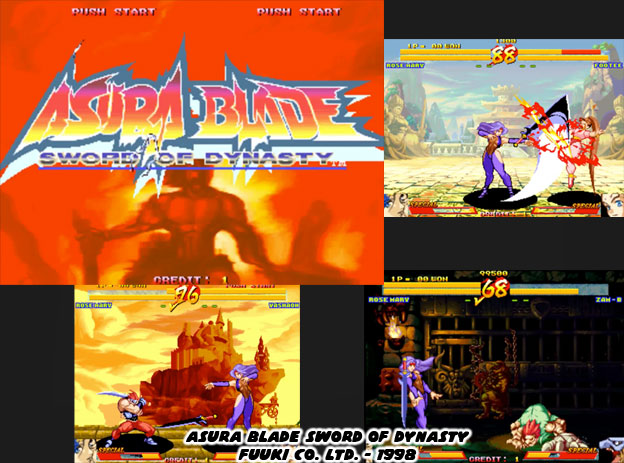
There were exotic locations, a magic system, an interesting story and eight adventurers that represented the usual archetypes. The majority were sword masters with a magic user, martial artist and even animated suit of armor thrown into the mix. Fuuki Co. Ltd. had done an excellent job with the character designs. There were elements that were familiar to audiences in each fighter, but nothing that was an outright copy from a rival studio. For example, one of the main characters was Yashou, he left his powerful clan behind so he could become a mercenary. His design was something like a modern samurai. He had the katana, and a forehead guard the hachi game, but he also wore pants and had metal armor which were things that weren't sported in Feudal Japan. This was also a fantasy world. There was no Japan, no Europe, Middle East or China but instead there were cultural references to each area. Certain armor, certain weapons and even level designs were meant to rekindle the ideas of a region but not Earth as we know it. Many of the characters were designed with this basic concept in mind.
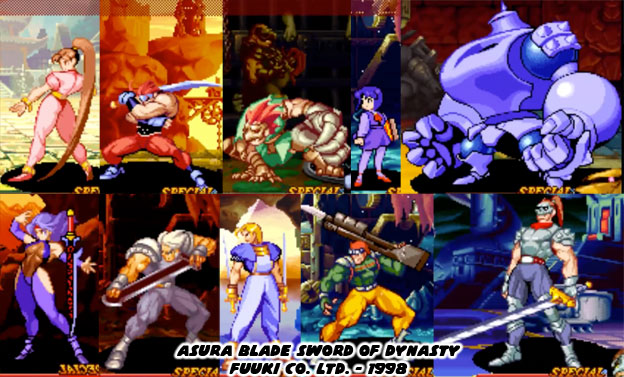
What made the game memorable, and for that matter what made most of the fantasy fighting games unique, was how Japan interpreted the fantasy theme. Every culture, every region of the world had its own customs and traditions. There were warriors, nobles, tradesmen and peasants in the biggest cultures. But then there were the ones living on the mystical side; the magic users, priests, priestess, spell casters, and shaman. These people were revered for their ability to make deals with spirits and demons. In some cases they were infamous for being able to become living monsters. When the west thinks of a magic character then a wizard often comes to mind. Usually they wear a robe, have a long white beard and sometimes a pointy cap. Basically they are references to the character Gandalf from the Lord of the Rings. Gandalf of course was an amalgamation of earlier wizard characters, including Merlin from the Arthurian legends. Japan of course didn't have characters in their storytelling traditions that looked like Gandalf. A wizard-like character might have been represented as a Shinto priest. Instead of waving a magical wand they would use a haraegushi "lightning wand" with paper streamers or shide to ward off evil spirits.
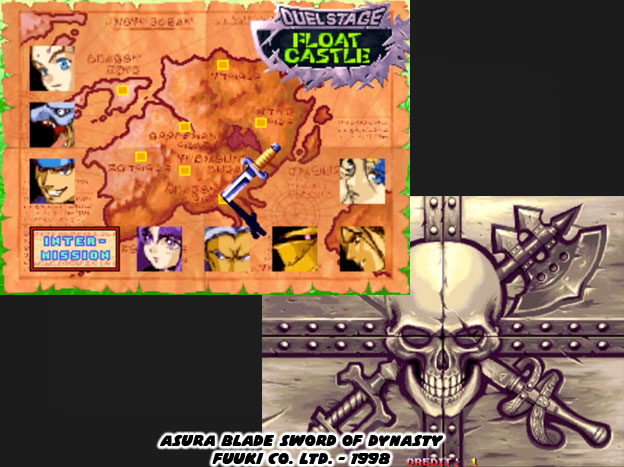
The Japanese designers would study western fantasy tropes and reinterpret them. For example maps had been a part of fighting game design going back to the original Street Fighter. We would follow our hero all across the globe. Yet maps in a fantasy fighter had all of the markings of a role playing poster. Take a look at the stage maps featured in the previous blogs. They had frayed edges, were written in an ancient language and had terrible sea creatures hiding in the corners. The history of creating detailed maps was as old as the storytelling tradition. Illustrated maps of fantastic places were featured in fairy tale books. Children could visualize spooky forests and haunted cottages more easily. Sometimes fantasy creatures appeared in actual maps and sea charts. Fantasy books like the Hobbit kept that tradition alive and sometimes included maps drawn by the main character of the story. Early tabletop games like Dungeons and Dragons had players create maps. These exotic places were sometimes printed in early fantasy magazines like Dragon and White Dwarf. They influenced the presentation of early PC and video game RPG's where maps were crucial to a quest. These traditions eventually made it to fighting games as well. The iconography of Western fantasy; skulls, serpents, gryphons, dragons, medieval weapons and armor, were all presented with a Japanese aesthetic.
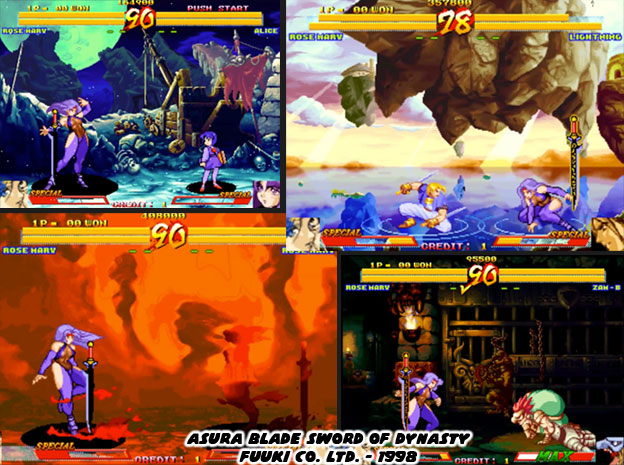
The locations featured in Asura Blade were especially memorable. Floating castles, hellish landscapes, mysterious dungeons and a ships graveyard were only a few of the places you could visit. They were the places that you would love to spend time exploring. Many Western RPG games used drab, toned-down color pallets. The designers at Fuuki Co. were not afraid to use bold colors. The graphics were among the brightest and most colorful for any game. They helped the backgrounds really pop. They made these fantasy characters look like they were stars in an anime show. Each person had tremendous personality. It was easy to read the faces of the characters. Every gesture was planned and animated to reinforce the persona of the fighter. Yashou had a wide, reckless stance, that showed off his fearless attitude. Whereas Goat was a more regal character with a rigid, calculated stance. The developers had clearly copied what worked in games like Samurai Spirits and Street Fighter Zero, which had an anime-influenced presentation.
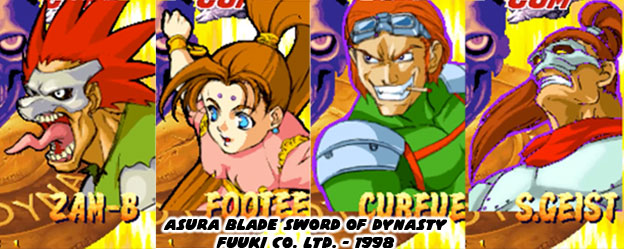
The animation and character design were good in Asura Blade, no so much for the originality but more so because they were poaching elements from other studios. You could look at the main cast and identify some characters that the developers were influenced by. The color scheme and revealing costume of Rose Mary was very much like Psylock from the X-Men / Marvel fighting games. Her magical sword was similar to Donovan's from the Vampire / Darkstalkers series. The animated suit of golden armor was very similar to the robot Huitzil / Phobos, also from Darkstalkers. Curfue the cigar-chomping sub-boss had a large gun and a stance reminiscent of Cable from the X-Men games as well. Zam-B the ninja with the large metal claw was clearly poached from Gen-An, the ninja with the large metal claw, from Samurai Shodown. In fact the overall sword fighting mechanics and special moves were heavily influenced by the Samurai Shodown series. This made Asura Blade one of the rare titles that had a taste of both Capcom and SNK for fighting game aficionados.
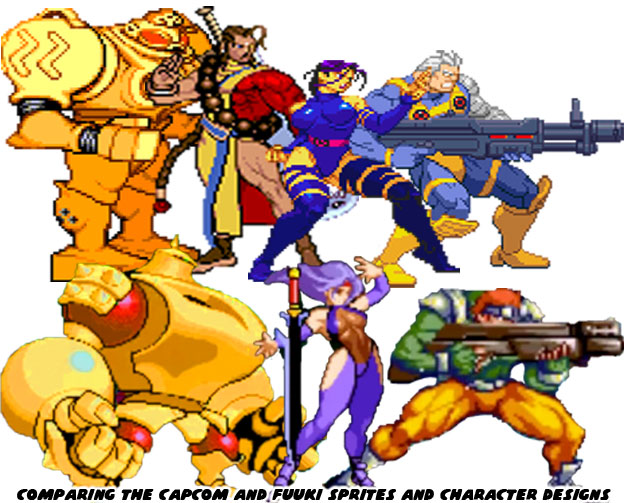
Sadly not many people got a chance to see or play this game. It came at the tail end of the fighting game's first wave of popularity, and more important, it came at a time when the arcade industry was cooling down. This didn't kill the genre, nor did it stop Fuuki Co. Ltd. It seems that they wanted to build a fighting game franchise. We'll look at their ambitious sequel in the next blog. As always if you enjoyed this blog and would like to sponsor me please visit my Patreon page and consider donating each month, even as little as $1 would help make better blogs and even podcasts!

No comments:
Post a Comment